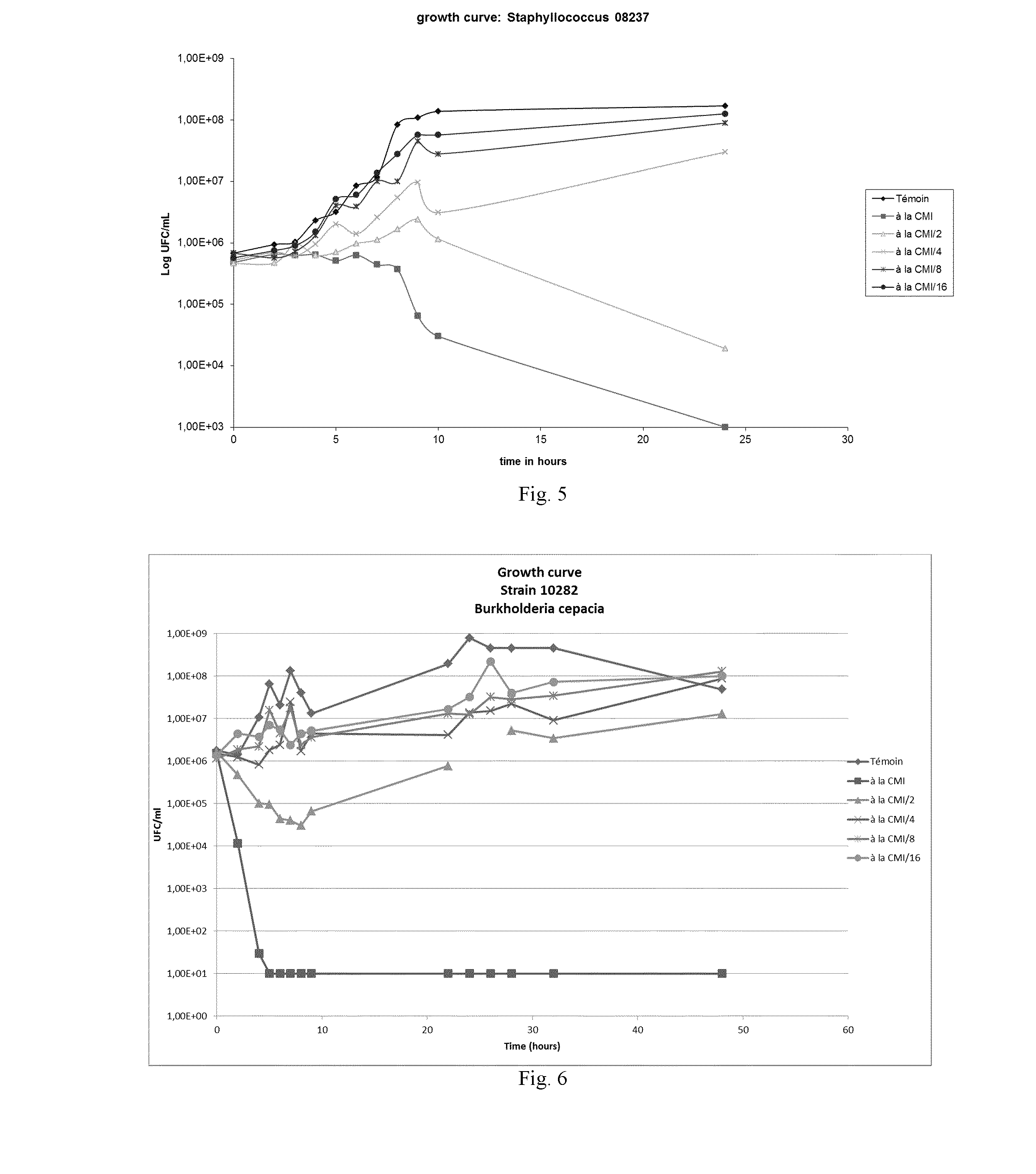Anti-microbial composition
a technology of composition and antimicrobial, applied in the field of antimicrobial, can solve the problems of bacteria having drug resistance, becoming a major health problem, expensive, etc., and achieve the effect of increasing the effect and/or the scope of the antiobitic, and increasing the effect and/or the scope of the active blend of the invention
- Summary
- Abstract
- Description
- Claims
- Application Information
AI Technical Summary
Benefits of technology
Problems solved by technology
Method used
Image
Examples
example 1
Bacterial Strains
[0308]The tested strains have been isolated from various samplings from human patients (blood, urines, pulmonary aspiration, etc). They have been isolated from patients non-infected at their admission to the hospital and who have developed an infection after at least 48 h of hospitalisation. The studied strains are as follows:
TABLE 1Enterobacteriaceaen = 89Citrobacter freundiiPhenotypic characterisation: Cephalosporinase, WSBL, WildGenotypic characterisation: CTX M1, CTX M15, KPC-2, NDM-1,TEM 3Enterobacter cloacaePhenotypic characterisation: Cephalosporinase (HN2), WSBL, WildGenotypic characterisation: GES-, KPC-2, NDM-1, NMC-A, OXA-43Escherichia coliPhenotypic characterisation: WSBL, Wild, Penicilinases,Fluoroquinolone resistance, Nalixidic acid resistanceGenotypic characterisation: CMY.2, CTX M1, CTX M14, CTX M15,CTX M3, KPC-2, NDM-1, OXA-30, OXA-48, SHV-12, SHV-2A,TEM-12, VIM-1, VIM-19, VIM-2Klebsiella pneumoniaePhenotypic characterisation: Penicillinase, wildGen...
example 2
Antibacterial Activity of Blend 1
[0309]Following a method allowing the dissolution of the active blend in a Mueller Hinton gelose the following MIC has been measured with the following active blend 1 consisting of 1% by weight of cineole, 2.4% by weight of linalool, 1.7% by weight of beta-caryophyllene, 86.7% by weight of trans-cinnamaldehyde, 5.35% by weight of trans-2-methoxycinnamaldehyde, 0.35% by weight of benzyl benzoate, and 2.5% by weight of cinnamyl acetate compared to the total weight of the active blend. Said active blend 1 having been tested at concentrations shown in the following table.
TABLE 2MICMICStrainType(% v / v)StrainType(% v / v)ATCC 25922E. coli0.038241Staphylococcus0.038127Pseudomonas0.1258152Enterococcus0.038128Pseudomonas0.1258153Enterococcus0.038129Pseudomonas0.1259001E. faecium0.038130Pseudomonas0.1259002E. faecium0.038131Pseudomonas0.039003E. coli0.038132Pseudomonas0.1259004E. aerogenes0.038133Pseudomonas0.1259007P. aeruginosa0.068134Pseudomonas0.1259008P. ae...
example 3
Antibacterial Activity of Active Blends 2, 3, 4 and 5
[0311]Following a method allowing the dissolution of the active blend in a Mueller Hinton gelose the following MIC has been measured with the following active blends:[0312]Active blend 2 consisting of 2.4% by weight of linalool, 1.72% by weight of beta-caryophyllene, 87.58% by weight of trans-cinnamaldehyde, 5.43% by weight of trans-2-methoxycinnamaldehyde, 0.34% by weight of benzyl benzoate, and 2.53% by weight of cinnamyl acetate compared to the total weight of the active blend, and[0313]Active blend 3 consisting of 1.04% by weight of cineole, 2.42% by weight of linalool, 88.19% by weight of tran s-cinnamaldehyde, 5.47% by weight of trans-2-methoxycinnamaldehyde, 0.35% by weight of benzyl benzoate, and 2.54% by weight of cinnamyl acetate compared to the total weight of the active blend,[0314]active blend 4 consisting of 2.41% by weight of linalool, 1.72% by weight of beta-caryophyllene, 87.88% by weight of trans-cinnamaldehyde, ...
PUM
| Property | Measurement | Unit |
|---|---|---|
| weight | aaaaa | aaaaa |
| total weight | aaaaa | aaaaa |
| drug resistance | aaaaa | aaaaa |
Abstract
Description
Claims
Application Information
 Login to View More
Login to View More - R&D
- Intellectual Property
- Life Sciences
- Materials
- Tech Scout
- Unparalleled Data Quality
- Higher Quality Content
- 60% Fewer Hallucinations
Browse by: Latest US Patents, China's latest patents, Technical Efficacy Thesaurus, Application Domain, Technology Topic, Popular Technical Reports.
© 2025 PatSnap. All rights reserved.Legal|Privacy policy|Modern Slavery Act Transparency Statement|Sitemap|About US| Contact US: help@patsnap.com



